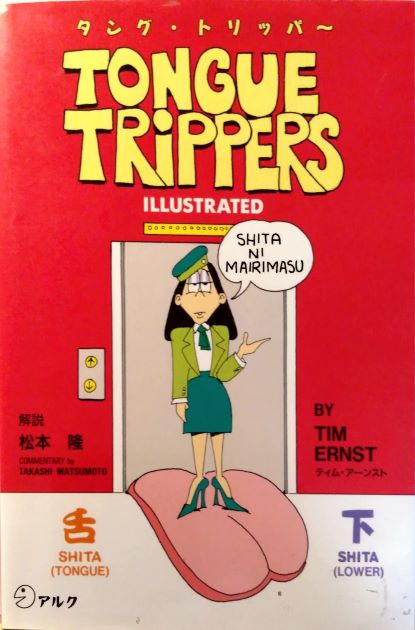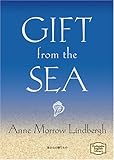(557) Important part of Japanese grammar [joke]
Katsura Sunshine is a Rakugo comic story teller. He is Canadian. He has lived in Japan for about 20 years. A few years ago, he did his performance in Tront Canada. He did his comic story in English. It's about Japanese language. It goes like this.
There is important part in Japanese grammar. It is called NOBASU. It is lengthening the vowel. It is almost imperceptible1) for Anglophone2) ear. If you lengthen the vowel you can really run yourself into trouble.
I will give you some pairs of words that are troublesome.
Tori --- bird,
Toori --- road.
Toori --- road.
Now, if you mistake a bird for a road or a road for a bird, are given that much trouble.
These get worse.
Obasan --- madam,
Obaasan --- old lady.
Obasan --- madam,
Obaasan --- old lady.
Shujin --- husband,
Shuujin --- prisoner.
Shuujin --- prisoner.
Komon --- supervisor,
Koomon --- ass hole.
Koomon --- ass hole.
His short story finished here.
--------------------------------------------------
1) imperceptible: not capable of being distinguished
2) Anglophone: a person who speaks English, especially in countries where English is not the only language that is spoken
--------------------------------------------------
1) imperceptible: not capable of being distinguished
2) Anglophone: a person who speaks English, especially in countries where English is not the only language that is spoken
--------------------------------------------------
I found "tori and toori" in a book, TONGUE TRIPPERS.

The pair of obasan and obaasan is also mentioned in this book.
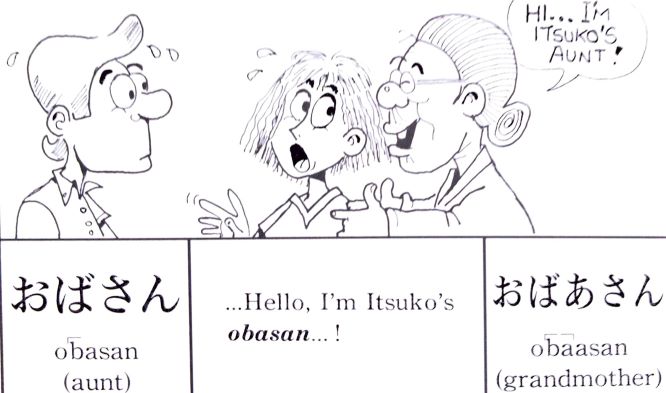
Even if you pronounce obasan properly, there is another thing to be careful. What you should be careful about is whether to address a middle-aged woman who is not your aunt as obasan or oneesan (used for younger women). This book advises like this. In cases where you're not sure which one to use, play it safe by using oneesan.
*
*
(556) Synchronicity of YADOKARI [調べる]
In the afternoon, I read about Yadokari in Hawkins's booklet.
In the evening, I saw Yadokari illustrations in a children's TV program. I knew Yadokari is a hermit crab in English, and remembered Natsume Soseki had a hermit-like personality.
At night, I found another hermit crab in a book, Gift from the Sea.
This state of being synchronous might be a kind of synchronicity of Yadokari, hermit crab.
In the evening, I saw Yadokari illustrations in a children's TV program. I knew Yadokari is a hermit crab in English, and remembered Natsume Soseki had a hermit-like personality.
At night, I found another hermit crab in a book, Gift from the Sea.
This state of being synchronous might be a kind of synchronicity of Yadokari, hermit crab.
One afternoon in February, at an online meeting, my friends and I enjoyed reading an old booklet written by an American teacher, Hawkins. He taught English in Matsuyama middle school in 1892 and 1893, 25 and 26 in the Meiji era. The school is now Matsuyama East high school. Hawkins wrote about his bathing in summer. He went to Takahama to swim. It goes like this.
Yesterday I picked up a shell, thinking to bring it home. As I held it a teacher called attention to some smaller shells upon the edge of the sea, in which very curious crab-like animals were making their homes, moving back and forth with the waves, crawling on one foot when the waves did not supply motive power. Looking at my shell, I saw the half of an ugly body protruding.
ーTwenty Months in Japanー
ーTwenty Months in Japanー

a naked YADOKARI (hermit crab)
I thought he didn't know of YADOKARI, because he just mentioned them as curious crab-like animals.
On the same evening, I was watching a children's program of NHK TV. Children tried to get anything begin with YA on the screen. Illustrations of YADOKARI appeared.
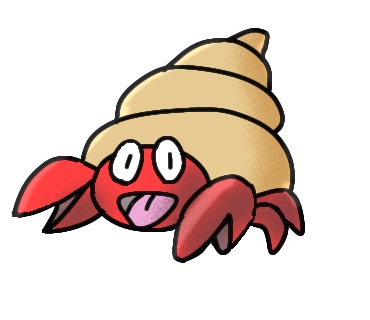 I instantly remembered about Hawkins's diary. It was a coincident happening.
I instantly remembered about Hawkins's diary. It was a coincident happening.
 I instantly remembered about Hawkins's diary. It was a coincident happening.
I instantly remembered about Hawkins's diary. It was a coincident happening. I just wondered what they call YADOKARI in English. I looked it up in a dictionary of smart phone for the first time. It said YADOKARI is a hermit crab in English. I was a little bit surprised at this word. Because western people expressed the crab as one who lives in solitude. Hermit is unfamiliar word for me, but I know it. Because Natsume Soseki used this word in his first letter from Matsuyama to his former teacher in Tokyo university. He wrote that he has a hermit-like personality, so it is difficult to live in an environment with close relationships of Matsuyama. Natsume Soseki became a teacher of English in Matsuyama middle school after Hawkins and Johnson left the school.
At the night, when I was thinking about a hermit crab, two books titled "Gift from the sea" were coincidentally, right next to me. I had brought them from the bookshelf a few days before. One is a paperback and the other is a pocket-sized one. I bought the same essays by mistake. I had not read them yet. But its title "Gift from the sea" reminded me of hermit crabs. I guess that something about a hermit crab must be written in this book. My guess was right. I found the writing about a hermit crab in the second chapter.
The shell in my hand is deserted. It once housed a whelk, a snail-like creature, and then temporarily, after the death of the first occupant, a little hermit crab, who has run away, leaving his tracks behind him like a delicate vine on the sand.
-Gift from the Sea-
-Gift from the Sea-

VINTAGE BOOKS EDITION, 1965
This book was published by Anne Morrow Lindbergh in 1955.
*
(555) Why I was afraid of kawauso. [英作文]
Hello everyone. I was afraid of kawauso.
Today, I'd like to report on one of little important topics. But I am very curious about this. My topic is why I was so scared of kawauso when I was small. You might say, "I'm not interested. You are just scaredy-cat. I don't care."
Please listen to me. It happened when I was a fourth-grade boy of elementary school. I was on the way home from school with my older friend. When we were walking beside the high school playground, he suddenly whispered to me. "You know what. There is a stuffed specimen of a real kawauso in a science room of the high school."
"Really does kawauso really exist in this world?" I froze in fear.
Let me make it clear. The English word for kawauso is the Japanese otter. It is just an animal.
But I don't know of real Japanese otters. I had never seen them. So, to me Kawauso really sounded like a scary unknown monster. All I can remember now is that freezing fear on the way home.
Out of curiosity, I decided to collect the information about kawauso. And I happened to get an old book, the Animal Chronicle in haiku.
This book says that kawauso stands up on its hind legs so was often mistaken as a human child.
I had another information on the internet. It is a scary story of being deceived by otters. Surprisingly it is a scary story told in Uwajima city, my home town. A man was walking alone on the street at night when he looked closely, it became to grow taller and taller as if it was going up into the sky. This monster is called Nobiagari.
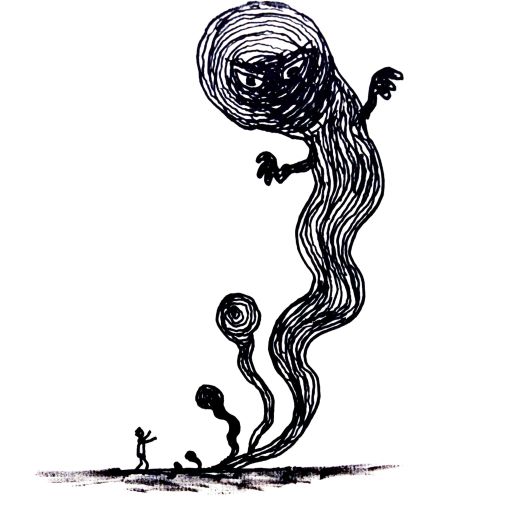
It startled the local people. They believe nobiagari is kawauso. Nobiagari monster is scariest to me. So, I am sure that nobiagari is my real reason why I was scared of kawauso. Now my question is solved completely.
In 2012 kawauso the Japanese otter became an extinct species. I feel sorry for kawauso. But it is too late.
Nowaday kawauso become very popular in Japan. The otter is a small-clawed otter, in Japanese kotsume-kawauso. There are many cute and friendly illustrations and stuffed toys of the otters.
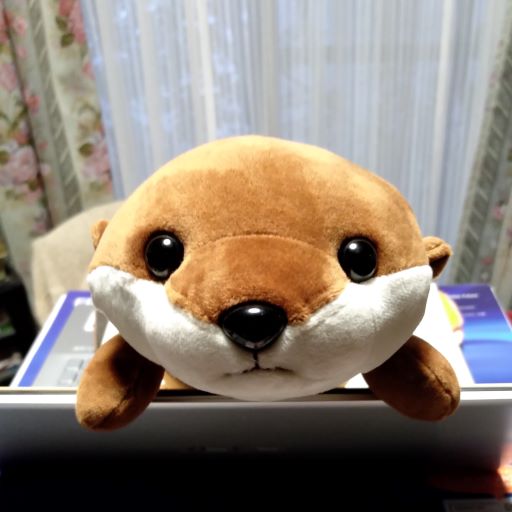
Fortunately, they still survive in several Asian countries. But are they really happy with us? I have come to know that most of the otters of all kinds in the world are now in danger of extinction. So, thinking about otters' happiness would be an important topic. I hope otters and people can live together friendly and peacefully from now on. Lastly otters are not scary folklore monsters but very cute animals which love to play.
Contest chair.
*
*

